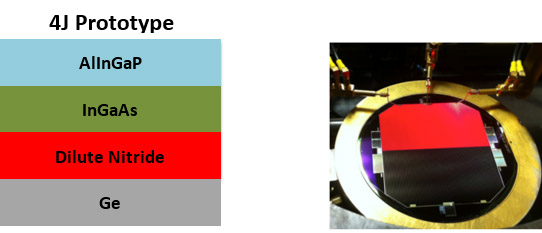- News
10 June 2015
Solar Junction developing four-junction cells for space applications
Solar Junction Corp (SJC) of San Jose, CA, USA, which makes what are reckoned to be the highest-efficiency commercially available multi-junction solar cells for terrestrial concentrated photovoltaic (CPV) applications, has announced plans to become a provider of solar cells for space power applications. Specifically, at the 2015 Space Power Workshop in Manhattan Beach, California (11-14 May), Solar Junction presented to the aerospace community its recent progress in developing next-generation space solar cells.
Solar Junction claims that, since introducing its terrestrial CPV technology more than seven years ago, it has proved that dilute nitrides can be produced in high volume on 6-inch wafers with industry-leading manufacturing yields and significant cost savings using molecular beam epitaxy (MBE). The firm is now poised to enter the space photovoltaics market. Its proprietary dilute nitride technology is lattice matched on both germanium (Ge) and gallium arsenide (GaAs) substrates, provides a range of bandgaps between 0.9eV and 1.4eV, and is the only technology platform that enables low-cost monolithic growth beyond three junctions, it is claimed.
Solar Junction is currently producing a high-efficiency three-junction (3J) space cell using its dilute nitride material as the bottom active junction on a GaAs substrate. Last year saw the first commercial shipment of the 3J space cell, with air mass zero (AM0) efficiencies exceeding 31%. The 3J product is currently undergoing qualification.

Picture: Image of AeroCube-6 A/B picosat from The Aerospace Corporation.

Graphic: Data provided by The Aerospace Corp.
During the Space Power Workshop, The Aerospace Corporation presented radiation degradation results from two Aerospace AeroCube picosats that have been on-orbit since June 2014 carrying Solar Junction 3J space cells. The results demonstrate that dilute nitride materials have radiation hardness comparable to conventional cells and show great promise for Solar Junction's next-generation space products, says the firm.

Enabled by its proprietary dilute nitride technology platform, Solar Junction is now developing a next-generation fully lattice-matched, four-junction (4J) space cell product. Early prototypes with an industry-standard Ge bottom junction have already reached AM0 efficiencies of 31%. Solar Junction plans bring to market its 4J lattice-matched, dilute nitride Ge-bottom-junction space cell by late 2016 with a minimum average efficiency of 33%.


